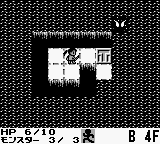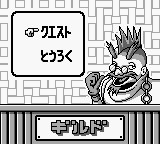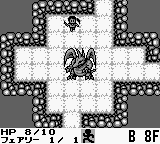Table of Contents
Cave Noire
Cave Noire is among the first handheld roguelikes ever created. While this might give one limited expectations due to the early nature of its release (early 1991), the game is actually quite well ahead of its time and rather unique in how it is formulated. The Game Boy has no shortage of games with puzzle elements to them, and Konami's twist on the roguelike genre puts it among the best of them.
In most games in the genre, the player is expected to traverse deeper and deeper, fighting bigger and tougher enemies while levelling up or improving their equipment and seeing just how far that they can go. In Cave Noire, the player is expected to do nearly the opposite — you're actually avoiding the vast majority of enemies entirely and trying to finish your objective before you go too deep. Enemies can take you out quickly and items that heal you or assist you in defeating them are very few and far between. It becomes a very methodical game of survival, where initiating combat can quickly end your game.
The player is able to select from four different missions with different objectives, each one getting progressively harder when cleared up to a final, tenth round. The first mission involves killing a certain number of enemies, the second involves collecting a certain amount of gold, the third involves gathering these rare, chalice-like items (that take up valuable inventory slots) and the fourth involves finding keys to free a certain number fairies from cages. Each mission takes place in a different cave with different tilesets, slightly different enemies and different, randomly-generated rooms.
The game's turn order and enemy behavior are the two most integral parts to how it plays. Enemy types all behave differently, so learning their movement pattern immediately becomes integral to success. Equally important to learning how they move is how the turns progress, which is in an order different from most games in the genre. The turn begins with the player choosing to either move or perform an action (use an item, pick up an item, etc.), followed by the player choosing to attack if they have an enemy in range and didn't perform an action aside from movement. The enemy then attacks, if the player is within range, and moves after that if they did not perform an attack.
Where this differs greatly from how other games work is that the enemy's attack step comes before their movement step. This encourages you to carefully study patterns to exploit them, and plan out your movement several turns ahead. Because enemies can only attack before moving, they can actually touch you for several turns without actually being able damage you. This creates some very tense moments, as just a single attack landing on you from a powerful enemy can mean immediate death or loss of precious hitpoints. Some enemy patterns involve following you, so you'll have a powerful enemy tailing you every step, sometimes catching you near a pit or corner (and sometimes tricking you into doing so while in darkness) and forcing you to face them.
Players are given four items before entering a cave and a total of eight item slots. Items perform various uses, such as temporarily increasing attack, healing or briefly turning the player invisible. Items can also be found that will boost stats. for the duration of your crawl in the cave or as long as they remain in your inventory. Given that items are fairly limited, treasure chests can often be difficult to get to without endangering yourself (and require a turn to open and another turn to pick up) and provide an interesting bit of risk and reward.
Cave Noire's biggest downside is that after playing it long enough, it's easy to grow weary of the somewhat repetitive tasks and the fact you're never really encouraged to go deeper and survive as long as possible. It's an incredible breath of fresh air for more than a fair sum of hours (especially for a Game Boy game), but it lacks a real significant lasting appeal and doesn't offer very much to come back to. It comes highly recommended to any fan of the genre or the hardware, especially given it's relatively low price for importing.
Legacy
Return Alive
For the 2012 iteration of selectbutton's annual game making event, Bakedown, Leon Arnott made Return Alive, taking obvious, and author proclaimed, inspiration from Cave Noire.
- [BD12] Return Alive [BAKEDOWN RELEASE] - The game's forum thread.
- Return Alive - HTML5 version of the game.
See also
- Post # 1087405 | Cave Noire - Sources for this wiki entry, written by Samantha McComb ('Kitten ClanClan').
- Project "Cave Noire" - Aeon Genesis English translation patch.
- Cave Noire - Comprehensive blog post, by 'Kimimi'.
- Cave Noire - HG101 article, by Kurt Kulata.
- Zaga-33 and Cave Noire - hostility and hospitability - Leon Arnott's forum topic comparing both games.



